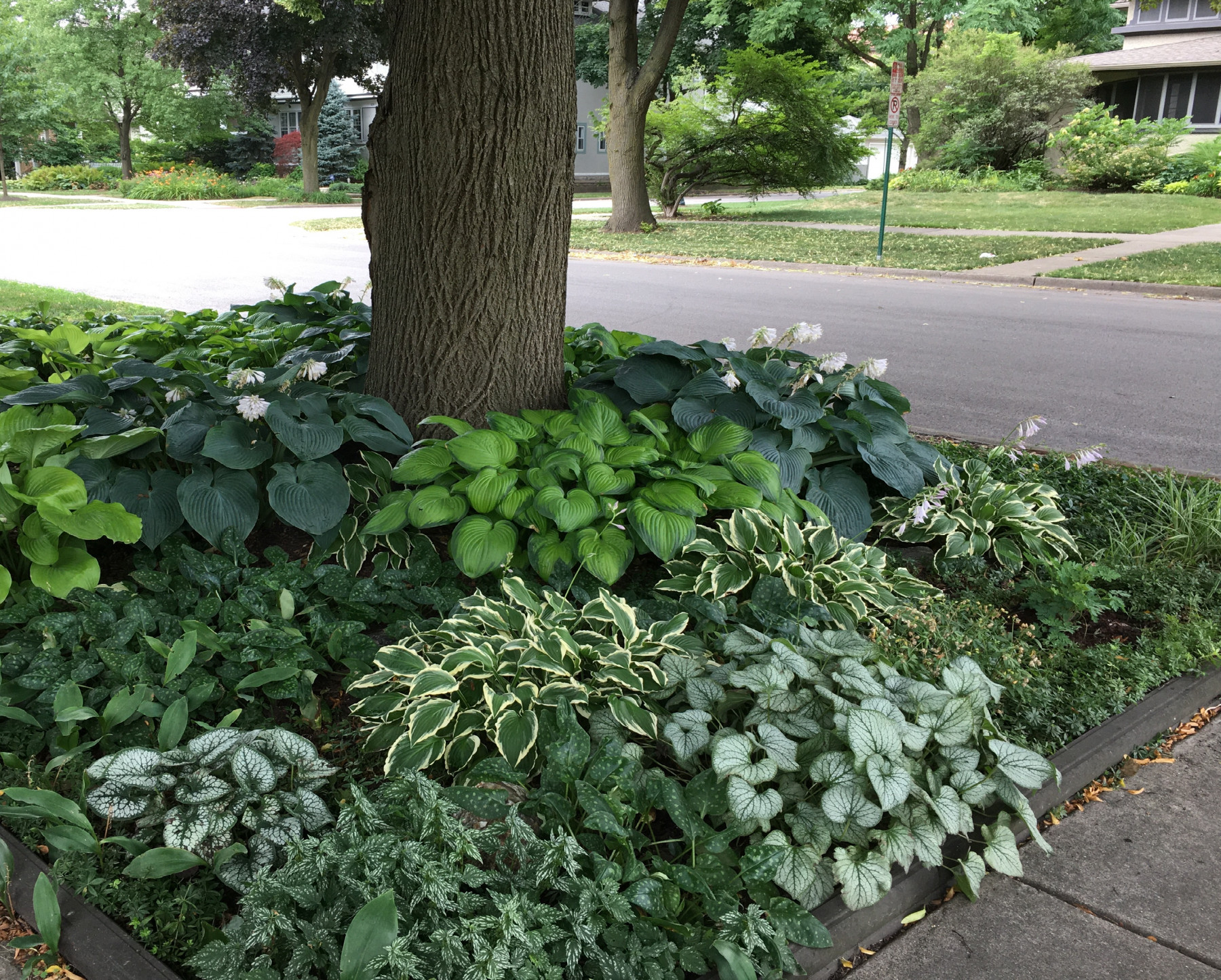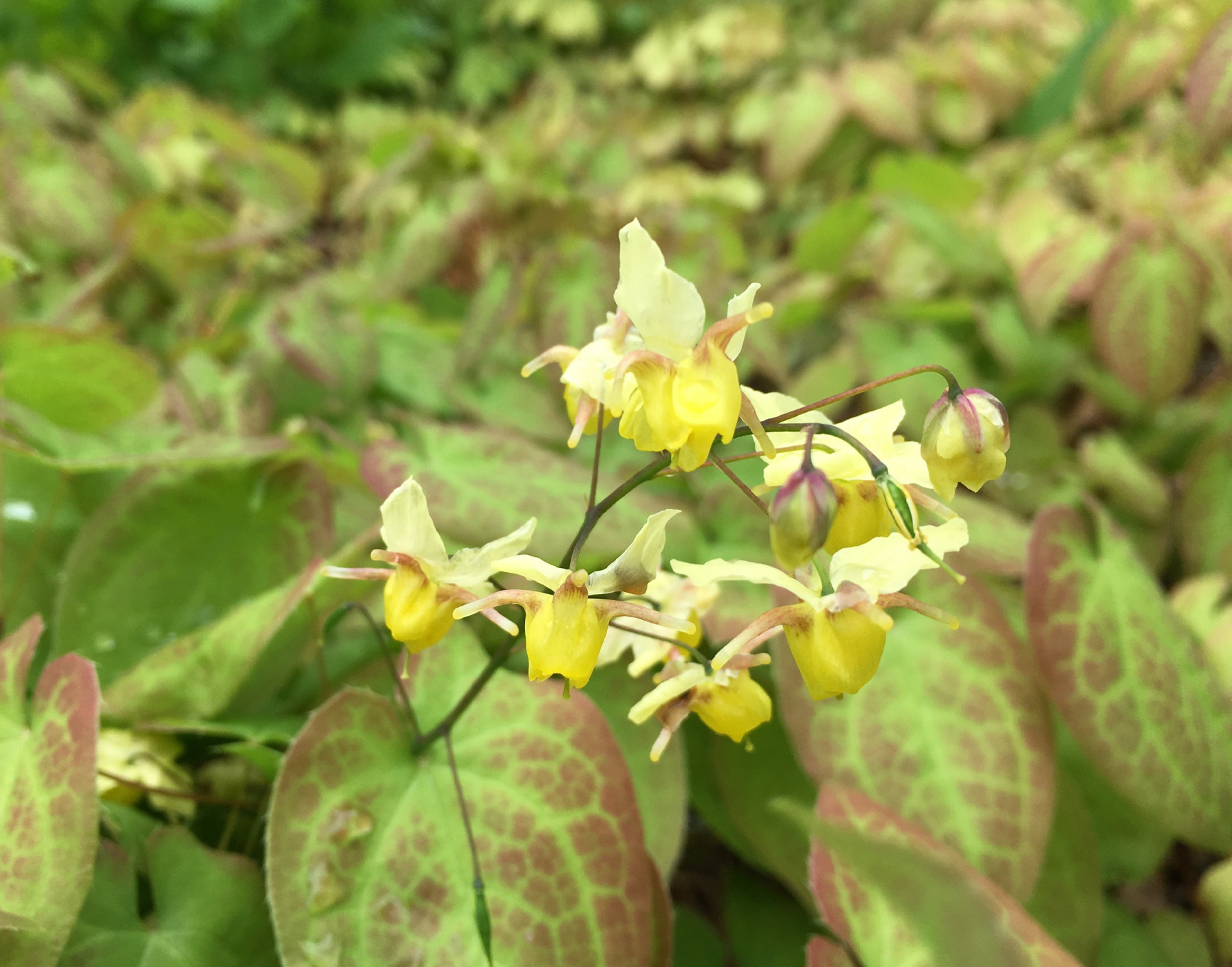
In American yards, the default way of covering the soil is grass. You’ll see yards with no trees, no shrubs, no flowers, but there’s nearly always at least a little patch of grass.
Very often the grass makes no sense. On city streets with tiny front gardens, shaded by trees and buildings, I’ll often see somebody using a polluting gas-powered mower to cut a lawn no more than 20 or 30 square feet. Why? I want to ask. There are so many better things to plant in a space too small and shady for a lawn! Things you won’t have to mow every week!
In large yards, I usually see grass growing right up to the base of mature trees, or at least trying. Grass actually doesn’t grow well under trees, for the simple reason that the grass species we use in lawns are full-sun plants and trees cast shade. When grass fails to thrive under trees, getting patchy and weedy, most homeowners blame the tree–although it’s the grass, not the tree, that is being asked to do something it just can’t do.
Being hemmed in by lawn is also bad for a tree. The grass roots are competing with the tree’s roots for water and nutrients. The grass is inviting the lawn mower to come too close to the tree trunk and damage the bark. And beneath turf grass, the soil will have a barren and impoverished ecosystem, not the rich, teeming soil food web that, in the forest, makes such a welcoming home for tree roots.
Because we ask lawn grasses to grow in a way they aren’t built for, they tend to be feeble and needy. They require watering, fertilizing, reseeding, and weeding, which unfortunately often takes the form of toxic herbicides. Turf grass is prone to diseases. Home lawns almost never look like major league baseball outfields or golf courses, which is where far too many homeowners get their inspiration.
So in late summer and early fall, when many people are reseeding lawns in vain attempts to grow thick, green grass in inappropriate places, I say: Just stop. Plant something else that will work better.

There’s a whole category of plants that are often called “ground covers.” It’s a functional label rather than a botanical category. What ground covers have in common is that they are naturally low-growing or creeping, spread readily, are often shade tolerant, and sometimes are more or less evergreen, depending on your climate. In the Midwest, the classics are plants such as English ivy (Hedera helix), spotted dead nettle (Lamium maculatum), myrtle (Vinca minor), and the native Canadian wild ginger (Asarum canadense), a favorite in my garden. Although most ground covers are planted for their carpet of leaves, some, such as myrtle, bugleweed (Ajuga reptans) and barrenwort (Epimedium), also bloom nicely in spring.
Ground covers aren’t the only way to surround trees or fill small, awkward patches of yard where grass would be senseless. Under a tree or in front of a city house, you can make a shade garden, with a mixture of perennials such as hosta and brunnera, ferns, native wildflowers, and early blooming bulbs such as Siberian squill (Scilla siberica) and snowdrops (Galanthus nivalis). In a dry, harshly sunny spot, such as along a driveway, try a creeping juniper, a naturally low-growing, drought-tolerant evergreen shrub.
These alternatives to grass aren’t carefree. You’ll still need to water, weed, and do some trimming and pruning. Many ground covers, such as English ivy and myrtle, spread aggressively and need to be regularly pulled up or cut back to keep them in bounds. In fall, it’s a good idea to trim evergreen ground covers back from the sidewalk to make snow shoveling easier in the coming winter. But I guarantee that it will add up to less work than if the same patch of ground is covered with lawn, and healthier and less polluting too.
Before you replace lawn with a ground cover or other plants, you’ll need to get rid of the grass. You can do this by digging up the turf with a sharpened spade or rented sod cutter. If you’ve got the time, you can kill grass by covering it for several weeks with weighed-down sheets of black plastic, which will trap heat and bake the grass plants. Under a tree, where the grass is struggling anyway, you may simply be able to simply yank up the remaining clumps.

When you plant under a tree, respect its roots. They grow out sideways, most within the top foot of soil and for a surprising distance. Every time you dig around a tree, you’re almost certainly damaging some roots. Ideally, you’d plant the ground covers at the same time you plant the tree, so the roots of the ground cover and the young tree can grow out together and companionably intermingle. Most likely, though, you’ll be planting around an established tree.
Start by spreading some compost–just an inch or two deep. It will benefit both your new plants and the tree’s existing roots. Use small plants so you can make small holes that will damage as few tree roots as possible. Ground covers may be sold in 4-inch pots or “plugs,” which are grown in trays, each with a long, deep, skinny clump of roots. If your trowel encounters a big root as you dig, don’t cut it; the tree needs it. Shift your planting hole to avoid it.
After planting, water thoroughly. Spread mulch just 1 to 2 inches deep over the new planting. Keep watering regularly. The planting will start out sparse but gradually fill in. When the tree’s leaves fall, let at least some of them remain around the new plants, gradually breaking down to enrich the soil.
There’s a place for some lawn in many yards. Kids need grass to romp on. It’s nice to have an open area where you can lie out in the sun or set a table for an outdoor party. Volleyball, badminton, croquet and catch need lawns. But in all the spots where nobody is ever going to play barefoot, there is nearly always something better to plant than grass.


